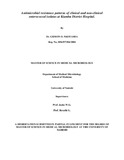| dc.description.abstract | This prospective study was carried out to determine the species distribution and antimicrobial
susceptibilities of enterococci isolated from clinical and nonclinical samples at Kiambu District
Hospital. Enterococcus species isolated from blood, urine, pus, ascitic fluid and stool specimen
between March 2011 and September 2011 were identified by standard biochemical tests.
Antimicrobial susceptibility testing was performed by disk diffusion method as per CLSI
guidelines. Out of a total of 139 Enterococcus species recovered during the study period, E.
faecalis (66, 47.5%) and E. faecium (39, 28%) constituted the predominant isolates (75.5%).
There were 34 (24.5%) other enterococcal species isolated. Of the 139 isolates 2 were recovered
from blood, 3 from ascitic fluid, 13 from urine, 21 from pus, 50 from patients’ stools and 50
from healthy control’s stools. Among the 39 non-stool clinical isolates, E. faecalis constituted
82%, E. faecium 15.4%. Species other than E. faecalis and E. faecium accounted for 2.6% of the
clinical, and for 33% of the faecal isolates. E. faecalis was predominantly isolated from pus,
urine, blood and ascitic samples. E. faecium and other enterococcal species were mainly isolated
from stool. Distribution of species among patients’ stools and healthy control’s stools were not
markedly different. Resistance to vancomycin was not detected. Overall, antibiotic resistance of
E. faecium isolates was more than that of E. faecalis or other enterococcal species. Resistance to
antibiotics among clinical isolates was higher than that in stool isolates. Resistance to ampicillin
was only observed among clinical isolates. Among clinical strains, overall resistance to
ampicillin was 7.7%, to gentamycin 17.9 %, and to streptomycin 35.9%. Prevalence of a wide
variety of Enterococcus species in clinical samples together with their variable antimicrobial
susceptibility patterns emphasizes the need for routinely carrying out detailed speciation and in
vitro susceptibility testing of enterococcal isolates in clinical bacteriology laboratories. | en_US |
| dc.description.department | a
Department of Psychiatry, University of Nairobi, ; bDepartment of Mental Health, School of Medicine,
Moi University, Eldoret, Kenya | |

